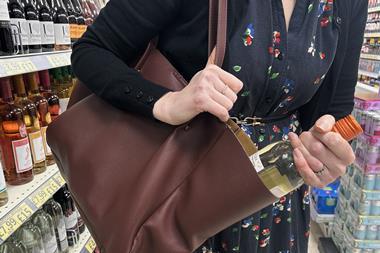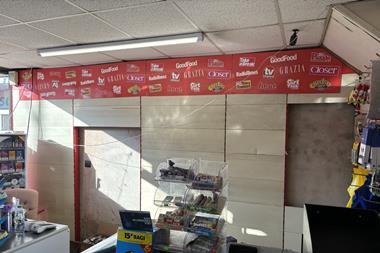Stores that are fully accessible can attract new customers, create a loyal customer base and see their sales ramp up as a result
The days of pokey convenience stores crammed with as many gondolas and FSDUs as possible may well soon be consigned to the dumpbin of history. Accessibility is now imperative as customers don’t just hope for high standards from independent convenience stores, they demand them.
New research from the Association of Convenience Stores (ACS) reveals that local shops across the UK have invested well over half a billion pounds in their businesses over the past year. The ACS Investment Tracker looks at the amount spent by store owners on improving their stores, including full refits and other structural changes.
One of the key reasons for such hefty investment is to make stores more accessible. Mos Patel, owner of Family Shopper Broadoak in Ashton-under-Lyne, Manchester, says: “When we had our extensive refit and re-opened in August, the main focus of the refit was to ensure accessibility for all. We wanted everyone to be able to come in and shop at our store, so everything has been done to make sure that is the case.
“We are in an area with lots of young people and there are a lot of young mums and dads with pushchairs, so it is important for them to be able to get through the door and shop the store with ease.”
All five of Kay Patel’s London stores have recently had a refit, with accessibility a big factor in the new designs. “Now all of my stores are highly accessible to everyone,” he says. “Our Wandsworth store is higher off the pavement than some of our other stores, so a ramp at the entrance is great for accessibility, but it also makes life easier for us when moving cages and such into the store and taking things out of the store, too.
“Our aisles in the Wandsworth store are 2m wide and we have accessibility ramps and wide doors on the store entrance. I have noticed that in some stores carers come in on behalf of the elderly person and leave them to wait outside as they can’t access the store, which is not right.
“We have a lot of customers with electric scooters or wheelchairs who come in on their own, or with carers, and they can come in and have plenty of room to shop and don’t have to wait outside. Stores should be accessible to everyone.”
Kay gained much of his advice from www.equalityhumanrights.com. “This website provides information on the current laws and regulations and is essential reading for retailers looking to make these changes,” he states.
Mos says ramps are essential for stores which aren’t on pavement level. He explains: “My advice to retailers is to maximise your store’s potential by appealing to everyone; the entrance is the key. If your store has steps, I recommend getting rid of them and introducing ramps and making the door wider and more accessible. You don’t want to discourage customers before they’ve even got through the door. We have ramps at the front and back of the store so customers can easily gain access. It also helps if we want to take cages into the store through the front.”
The doorway was also key to making Mos’ store more welcoming and accessible. “We had a 3m-wide door put in, so you can fit two push chairs through with ease, as well as wheelchairs and scooters. If people literally can’t get through the door, or have to leave pushchairs or things outside, they won’t come in, so it is vital that the store is welcoming from the outside.”
Mos also installed cameras outside and inside the store, with big screens displayed in store, in case customers prefer to leave a pushchair outside and carry a child in the store, although this is not common. He is also careful to ensure that his aisles don’t get filled up with POS units. “I personally hate dump bins and displays in the middle of aisles,” says Mos.
“I think they make the place look a bit untidy and disrupt shoppers and make it more difficult for them to navigate the store for themselves. But if retailers are going to use them, then I recommend putting them at the till point area or in corners that don’t block off walkways.”
A more spacious store has also resulted in a more unexpected benefit, he adds. “By having wider aisles and more space you can also notice a reduction in shoplifters, because on CCTV it is easier to notice someone leaning over and taking something, so there are lots of benefits for retailers who opt to maximise the space in their stores. All of the aisles in our store are between 1.2m and 1.3m wide.”
Scottish retailer Sid Ali, who owns four Nisa stores in Aberdeenshire, opened his fourth store, a 1,200sq ft outlet in Strichen, in September, and accessibility was an important issue from the start.
He says: “We put shopper navigation at the forefront of our plans. We wanted to encourage customers to explore different areas of the store and get around easily. We made sure we had nice wide aisles that allow wheelchairs and pushchairs to fit easily, with space to manoeuvre round and back again. This is also the case at our first store in Mintlaw, where the expansions we’ve had over the years have led to maximised accessibility and really wide aisles that allow a wheelchair and probably about two people to walk down at the same time.”
Meten Lakhani, owner of Premier St Mary’s, Southampton, says: “We got advice from Booker and our customers before we decided to expand the aisles by half a metre, so now they are more than 1m wide. Now, parents with pushchairs do a bigger shop with basket spends almost doubled. The refit doubled our footfall, with 20% of that attributed to making the store more accessible.”
Accessibility can also win over new customers, according to Kay. He says: “I would highly advise retailers to look into measures to create more space in store and make the store accessible to everyone, whether it is families with pushchairs, elderly people or disabled people, because we have earned a lot more customers by making simple changes. By having a ramp and wider doors and wide aisles, we have benefitted by attracting more customers from those communities.”
Top Tips
The retailer’s guide to accessibility
There are many ways to improve your store’s accessibility and plenty of advice on how to do it can be found online. Kay Patel, owner of five stores in East London, recommends checking out The Equality and Human Rights Commission’s guidelines.
The advice states that where a physical feature puts people using a service at substantial disadvantage, an organisation must take reasonable steps to:
Remove the feature
Alter it so that it no longer has that effect
Provide a reasonable means of avoiding the feature, or provide a reasonable alternative method of making the service available.
Retailers must think about what it is reasonable to change so that people with a range of different impairments are able to buy your goods. If businesses can’t afford things such as permanent ramps and automatic doors, or are refused planning permission, they could consider:
Keeping a temporary ramp just inside the door or installing a simple doorbell next to the door and put a notice in the shop window saying ‘If you require assistance, please ring this bell’
Explain to all staff the duty to make reasonable adjustments. For example, greeting customers if staff notice they have a visual impairment and offering assistance
Spend a small amount of money on a portable induction loop to make it easier for customers who use hearing aids to hear what is said to them
Make the entrance a different colour from the surrounding shop front
Designate any parking spaces close to the entrance for disabled customers
Move display units at the entrance of a small shop which otherwise stop wheelchair users and pushchairs from entering.
For more information and guidance
visit www.equalityhumanrights.com





















No comments yet